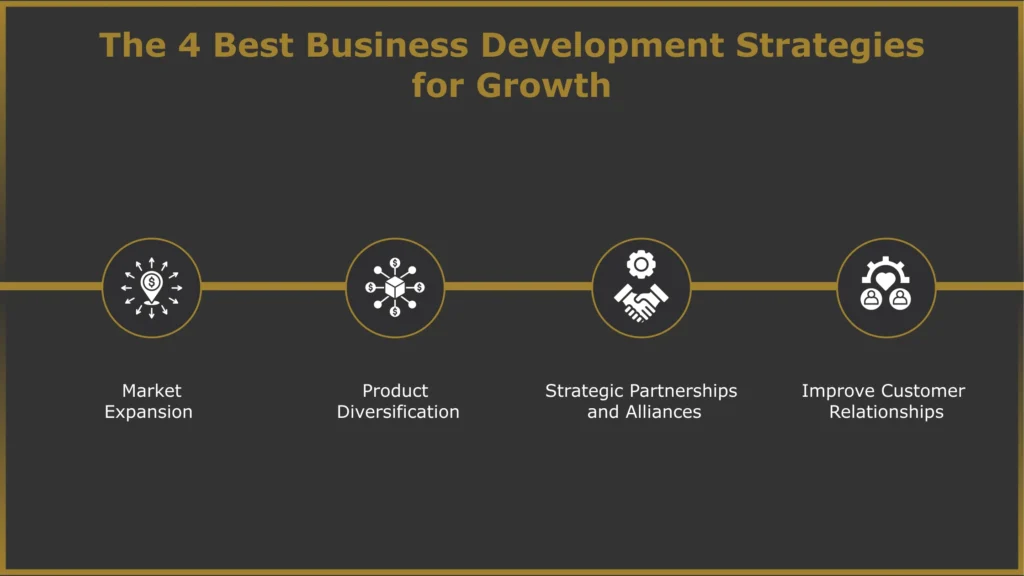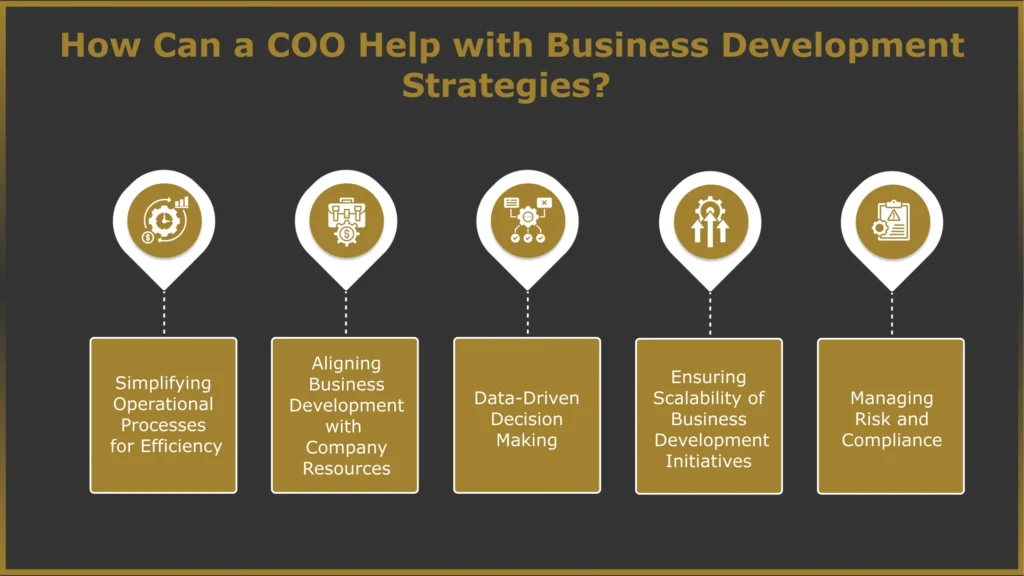Business development isn’t just for large companies anymore. It’s equally important for proprietors and small businesses. As someone running your own venture, you’re likely always exploring ways to sharpen your skills, expand your network, and grow your business.
Selecting the best business development strategies can open new opportunities for your business. Fifteen years of research by McKinsey Global reveal a clear pattern: Companies implementing more transformation actions are more likely to succeed.
So, how do you approach organizational development strategies? Let’s explore what they mean, how the process works, and how they can help you achieve sustainable growth.
What Is a Business Development Strategy?
|
A business development strategy is a detailed plan that outlines how a company intends to identify and secure new clients and business opportunities to enhance growth and profitability. It focuses on building long-term value through relationships with customers, exploring new markets, and forming strategic partnerships. The strategy provides a roadmap for the specific actions and approaches needed to achieve these objectives efficiently. |
Why Is a Strong Business Development Strategy Important?
A strong business development strategy is essential as it acts as a roadmap, guiding teams to identify and pursue high-quality leads aligned with the company’s long-term objectives. Without a well-defined business development plan, employees risk targeting unqualified prospects or investing time in relationships that do not yield substantial results.
The process of business development can vary between organizations but typically follows a three-stage funnel approach:
- Attracting Prospects: Initiating marketing efforts to generate interest and draw potential clients.
- Building Engagement: Developing strategies to nurture these relationships and sustain interest over time.
- Turning Opportunities into Clients: Implementing sales-focused tactics to finalize deals and convert opportunities into revenue.
The Business Strategy Development Process
Your business strategy development process should be as follows:
- Define Objectives: Set clear, measurable goals aligned with your company’s vision and mission.
- Analyze Current State: Assess strengths, weaknesses, opportunities, and threats (SWOT analysis) to understand the organization’s position.
- Market Research: Study industry trends, competitor strategies, and customer needs to identify growth opportunities.
- Formulate Strategy: Develop a plan outlining key initiatives, resource allocation, and timelines to achieve objectives.
- Implementation Plan: Assign roles, establish processes, and deploy resources to execute the strategy effectively.
- Monitor and Adjust: Use KPIs and feedback to track progress, improve, and adapt to changing circumstances.
The 4 Best Business Development Strategies for Growth

The most effective business development strategies include networking, referrals, advertising, and content marketing. By applying these B2B business development strategies properly, businesses can build and sustain strong partnerships and professional relationships.
Strategy 1: Market Expansion
Developing a marketing plan for market expansion focuses on reaching new customers or entering untapped markets to grow your business. Your organization should consider market expansion when your existing products or services are successful in current markets but may also appeal to broader or different audiences. To effectively plan for market expansion, consider the following steps:
Identify New Segments: Analyze your current customer base to find patterns or unmet needs that could be addressed in other demographics, industries, or geographic areas.
Leverage Data and Research: Use market research and data analysis to assess the demand, competition, and barriers to entry in new markets. In 2023, almost 92% of organizations reported that their investments in data and analytics resulted in measurable value, highlighting the increasing importance of data-driven decision-making.
Adapt Offerings: Tailor your products, services, or pricing to fit the preferences and needs of the target market.
The Benefits of Market Expansion
- Increased Revenue Potential: By reaching a larger audience, you open up new opportunities for sales, thereby increasing your potential for higher revenue.
- Diversification of Customer Base: Expanding into new markets reduces your reliance on a single market, which can help stabilize your business during economic fluctuations or industry-specific downturns.
- Enhanced Brand Visibility and Reputation: Operating across multiple regions or segments can boost your brand’s visibility and strengthen its reputation, making your business more recognizable and trusted by a wider audience.
Example
A company specializing in fitness equipment for gyms can expand by targeting home users with compact, easy-to-use equipment. Similarly, a business with a strong presence in North America could explore opportunities in emerging markets like Asia or South America to tap into new customer bases.
Strategy 2: Product Diversification
Product diversification is one of the most influential business development strategies. It involves expanding your product or service offerings to attract customers or enter new markets. Introducing new products that complement your existing offerings reduces the risk associated with market fluctuations and increases your growth potential. 72.6% of organizations report a positive impact from their strategies of product diversification and enhancing brand equity. To effectively implement product diversification, consider the following steps:
Develop New Products or Services: Identify gaps in the market or areas where your current offerings can be expanded or improved. This could involve introducing new features, creating new product lines, or offering complementary services.
Take Advantage of Existing Strengths: Use the knowledge, brand loyalty, or customer relationships you’ve already built to support new product launches.
Test the Market: Introduce new products in a controlled environment, such as a pilot market or limited release, to gather feedback and refine your approach.
The Benefits of Product Diversification
- Revenue Growth: By introducing new products, you can open additional revenue streams, expanding your financial base and potential for profit.
- Risk Mitigation: Diversifying your offerings across multiple products or services helps reduce reliance on a single revenue source, buffering your business against market fluctuations.
- Competitive Advantage: A diversified product portfolio can differentiate your company from competitors, especially if your new products meet previously unaddressed needs.
Example
A smartphone manufacturer can diversify by adding wearable devices like smartwatches or fitness trackers. Similarly, a food company might expand from offering snacks to launching a new line of beverages, catering to changing consumer preferences or seasonal demands.
Strategy 3: Strategic Partnerships and Alliances
Strategic partnerships and alliances are important business development strategies that involve collaborating with other organizations to leverage mutual strengths, access new markets, and enhance offerings. These partnerships can take many forms, including joint ventures, co-marketing initiatives, distribution agreements, and technology collaborations. Consider the following:
Identify Potential Partners: Look for companies that offer complementary products, services, or expertise. Ideal partners should share a similar vision and values while offering capabilities you lack.
Build Win-Win Agreements: Create partnerships where both parties benefit. This could involve sharing resources, expanding market reach, or co-developing products. It’s essential to establish clear expectations and measurable outcomes from the outset.
Benefit from Joint Resources: Pool together your strengths—technology, customer bases, distribution channels, or brand power—to expand your market presence more effectively than if operating independently.
The Benefits of Strategic Partnerships
- Access to New Markets: A partnership can provide you with access to new geographies or customer segments, increasing your market reach.
- Cost and Risk Sharing: Collaborating with a partner allows for sharing the costs and risks of new ventures, whether in product development, marketing, or distribution.
- Increased Credibility and Reputation: Partnering with a well-established organization can boost your credibility and reputation, especially when entering unfamiliar markets.
Example
A software company may partner with a hardware manufacturer to create a bundled product, increasing the appeal to a broader audience. Similarly, a small startup may ally with a larger, more established brand to gain credibility and access to its customer base, leading to accelerated growth.
Strategy 4: Improve Customer Relationships
Building and maintaining strong relationships with existing customers is one of the most effective ways to promote long-term business growth. Good customer relationships lead to more loyal customers, increased repeat sales, and more referrals, which can significantly impact your profits.
Personalized Communication: Engage with your customers regularly and in a personalized manner. Whether through email marketing, social media interaction, or customer service follow-ups, understanding customer preferences and addressing their needs individually creates a stronger bond. 80% of digital marketing professionals believe personalized content greatly boosts consumer engagement.
Customer Feedback and Satisfaction: Regularly solicit customer feedback to understand their experiences and areas for improvement. This can be done through surveys, reviews, or direct conversations. Implementing their suggestions improves products or services and shows customers that their opinions are valued.
Loyalty Programs: Develop programs that reward repeat customers with discounts, exclusive offers, or early access to new products. This encourages continued business and makes customers feel appreciated.
Proactive Problem Solving: Anticipating and resolving customer issues before they become significant problems fosters trust and goodwill. Customers are more likely to stay loyal to a business that resolves their concerns promptly and effectively.
The Benefits of Enhancing Customer Relationships
- Increased Retention: Strong relationships keep customers returning, reducing churn rates and boosting lifetime customer value.
- Brand Advocacy: Loyal customers are likely to recommend your brand to others, leading to organic growth through word-of-mouth marketing.
- Higher Profitability: Acquiring new customers can be more costly than retaining existing ones. By enhancing relationships with current clients, you are investing in a more cost-effective approach to growth.
Example
A subscription-based business, like a SaaS company, may provide personalized onboarding, offer regular check-ins with dedicated account managers, and actively seek customer feedback to enhance its offerings. This proactive engagement increases retention rates and creates strong advocates for the brand, resulting in customer-driven growth.
How Can a COO Help with Business Development Strategies?
The Chief Operating Officer (COO) plays a crucial role in driving the execution and success of business development strategies within an organization. While business development often focuses on client acquisition and market expansion, the COO ensures that these strategies are aligned with operational capabilities, efficiently executed, and scalable for growth. Here are several ways a COO can contribute:
1. Simplifying Operational Processes for Efficiency
One of the COO’s primary responsibilities is overseeing the company’s day-to-day operations. The COO ensures smooth operations and support business development efforts by optimizing workflows and reducing inefficiencies.
For example, a COO can implement standardized processes for handling new client inquiries or managing product delivery, allowing the business development team to focus on growth without being hindered by operational bottlenecks. This operational efficiency is critical for scaling business development efforts, significantly when expanding into new markets or launching new products.
2. Aligning Business Development with Company Resources
A COO ensures that resources are allocated effectively across departments to support business development strategies. This includes managing staffing levels, budgeting, and ensuring the right technology and tools are in place. The COO enables business development teams to target the right prospects, engage effectively, and close deals more efficiently.
3. Data-Driven Decision Making
Data is essential for making informed business decisions. A COO can implement systems to collect and analyze key performance indicators (KPIs) related to business development efforts. Using data and analytics, the COO can assess the effectiveness of strategies like market expansion or customer relationship management.
4. Ensuring Scalability of Business Development Initiatives
As business development efforts lead to growth, the COO is responsible for scaling operations accordingly. This involves ensuring that infrastructure, supply chains, and human resources can handle the demand increase that often accompanies successful business development strategies. The COO’s ability to scale operations without sacrificing quality or efficiency is essential to sustaining long-term growth.
5. Managing Risk and Compliance
When entering new markets or launching new products, companies often face increased risks related to legal compliance, market conditions, and operational challenges. A COO plays a key role in managing these risks by establishing frameworks to mitigate potential issues. This could involve ensuring that the company adheres to relevant regulations, monitoring changes in market dynamics, or managing risks associated with new business partnerships.
Drive Business Growth with the Right Operational Leadership!

The role of a COO in shaping and executing business development strategies is indispensable for any company looking to scale effectively.
At Outcomes COO, we provide expert operational leadership that aligns with your business development goals. Our team is here to help you build scalable operations, navigate market challenges, and implement the right strategies to achieve measurable growth.
Here’s what we can do for you:
- Fractional COO Services: We provide experienced leadership for companies that don’t yet need a full-time COO but require expert operational support.
- Strategic Guidance: Our team helps you identify and implement the right strategies, from market expansion to customer relationship management.
- Operational Efficiency: We optimize internal processes and ensure alignment across all departments for smoother operations.
Explore how our tailored operational leadership solutions can drive your success.

